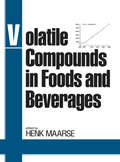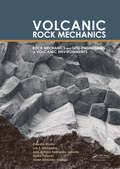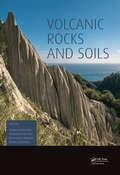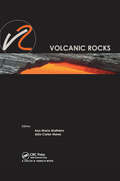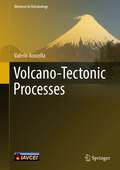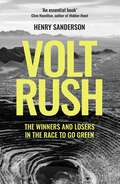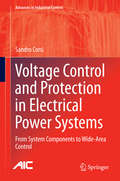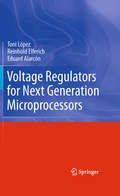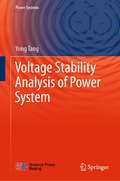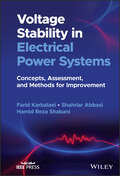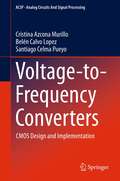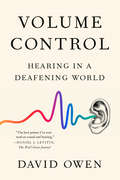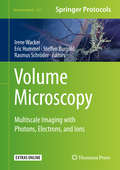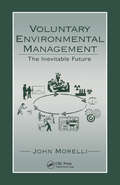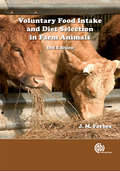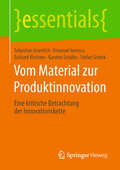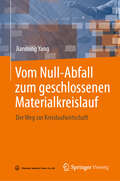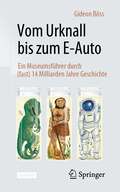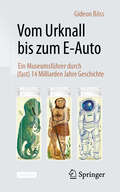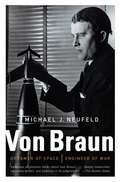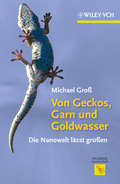- Table View
- List View
Volatile Compounds Formation in Specialty Beverages (Food Biotechnology and Engineering)
by Felipe Richter Reis Caroline Mongruel Eleutério dos SantosBeverages are a convenient and versatile product that may either serve to fulfill consumers’ needs for hydration or as a pleasant liquor. Among the sensory attributes of beverages that drive consumer acceptability is aroma, directly influenced by the quantity and type of volatile compounds contained inside them. Volatile Compounds Formation in Specialty Beverages contains remarkable information about volatile compounds of specialty beverages, addressing aspects involved from production processes to biochemical pathways. Divided in two sections, this book answers such key-questions as like how different classes of volatile compounds affect the specialty beverage sensory profile; furthermore, the section on distilled beverages brings supplies information on the contribution of maturation to the beverage volatile profile. Key Features: Provides information on the contribution of each class of volatile compounds to the beverages’ aroma Describes the biochemical pathways involved in the volatile compounds generation Covers both traditional and exotic, fermented, and distilled beverages Shows how the production process affects the volatile compounds formation Organized by experienced editors and written by authors from around the world, this book describes the most important aspects of volatile compounds formation in traditional beverages like whisky and sparkling wine, as well as in exotic beverages like cachaça and kombucha. It is a unique source for food scientists, chemists, chemical engineers and other professionals interested in learning about volatile compounds formation in fermented and distilled beverages.
Volatile Compounds in Foods and Beverages (Food Science And Technology Ser. #44)
by Henk MaarseCollects the information available in the literature on volatile compounds in foods and beverages. This information is given in 17 chapters, each dealing with a specific product or product group. Only compounds that are major constituents and/or contribute significantly to the flavor of the relevant
Volcanic Rock Mechanics: RockMechanics and Geo-engineering in Volcanic Environments
by Áurea Perucho Claudio Olalla Luis E. Hernández J.A. Rodríguez-Losada Javier González-GallegoVolcanic Rock Mechanics includes papers and special lectures of the 3rd International Workshop on Volcanic Rocks, Rock Mechanics and Geo-Engineering in Volcanic Environments, which was held within the framework of the Congress �Cities on Volcanoes6-Tenerife 2010� (Puerto de la Cruz, Tenerife, Spain, 31 May � 4 June 2010). The book is a comprehensiv
Volcanic Rocks and Soils
by Tatiana Rotonda, Manuela Cecconi, Francesco Silvestri and Paolo TommasiVolcanic rocks and soils show a peculiar mechanical behaviour at both laboratory and in-situ scale due to their typical structural characters. Volcanic rocks and soils contains keynote lectures and papers from the International Workshop held in Ischia (Italy), 24-25 September 2015. The book deals with recent developments and advancements, as well as case histories, in the geotechnical characterization and engineering applications related to volcanic formations. It covers a variety of themes, including: • Geotechnical characterization under both static and cyclic/dynamic loading conditions, with special regard to structural properties at different scales (microstructural features; field and laboratory characterization; construction materials); • Geotechnical aspects of natural hazards (slope stability; seismic risk); • Geotechnical problems of engineering structures (foundations; embankments; excavations and tunnels). Volcanic Rocks and Soils is of interest to scientists and practitioners in the fields of rock and soil mechanics, geotechnical engineering, engineering geology and geology.
Volcanic Rocks: Proceedings of ISRM Workshop W2, Ponta Delgada, Azores, Portugal, 14-15 July, 2007
by Ana Maria MalheiroEnvironmental issues are high on the public agenda and engineering projects need to take environmental concerns on board. Volcanic Rocks, contains papers from the ISRM Workshop W2 (Ponta Delgada, Azores, Portugal 14-15 July 2007), and focuses specifically on problems associated with construction activities in areas of volcanic rock. Volcanic Rocks highlights novel approaches and solutions to engineering problems in volcanic areas, covering a variety of topical themes, which include: characterization of volcanic formations; case studies; construction materials; earthquake engineering and rock dynamics; foundations; slope stability, and tunnelling.
Volcano-Tectonic Processes (Advances in Volcanology)
by Valerio AcocellaVolcanoes have terrified and, at the same time, fascinated civilizations for thousands of years. Many aspects of volcanoes, most notably the eruptive processes and the compositional variations of magma, have been widely investigated for several decades and today constitute the core of any volcanology textbook. Nevertheless, in the last two decades, boosted by the availability of volcano monitoring data, there has been an increasing interest in the pre-eruptive processes related to the shallow accumulation and to the transfer of magma approaching the surface, as well as in the resulting structure of volcanoes. These are innovative and essential aspects of modern volcanology and, as driving volcanic unrest, their understanding also improves hazard assessment and eruption forecasting. So far, the significant progress made in unravelling these volcano-tectonic processes has not been supported by a comprehensive overview.This monograph aims at filling this gap, describing the pre-eruptive processes related to the structure, deformation and tectonics of volcanoes, at the local and regional scale, in any tectonic setting. The monograph is organized into three sections (“Fundamentals”, “Magma migration towards the surface” and “The regional perspective”), consisting of thirteen chapters that are lavishly illustrated. The reader is accompanied in a journey within the volcano factory, discovering the processes associated with the shallow accumulation of magma and its transfer towards the surface, how these control the structure of volcanoes and their activity and, ultimately, improve our ability to estimate hazard and forecast eruption.The potential readership includes any academic, researcher and upper undergraduate student interested in volcanology, magma intrusions, structural geology, tectonics, geodesy, as well as geology and geophysics in general.
Volt Rush: The Winners and Losers in the Race to Go Green
by Henry Sanderson'A remarkably hopeful and useful book...The climate crisis leaves us no choice but to build a new world and as Sanderson makes clear, we are capable of making it a better one than the dirty and dangerous planet we&’ve come to take for granted.' Bill McKibben, Observer book of the week We depend on a handful of metals and rare earths to power our phones and computers. Increasingly, we rely on them to power our cars and our homes. Whoever controls these finite commodities will become rich beyond imagining. Sanderson journeys to meet the characters, companies, and nations scrambling for the new resources, linking remote mines in the Congo and Chile&’s Atacama Desert to giant Chinese battery factories, shadowy commodity traders, secretive billionaires, a new generation of scientists attempting to solve the dilemma of a &‘greener&’ world.
Voltage Control and Protection in Electrical Power Systems
by Sandro CorsiBased on the author's twenty years of experience, this book shows the practicality of modern, conceptually new, wide area voltage control in transmission and distribution smart grids, in detail. Evidence is given of the great advantages of this approach, as well as what can be gained by new control functionalities which modern technologies now available can provide. The distinction between solutions of wide area voltage regulation (V-WAR) and wide area voltage protection (V-WAP) are presented, demonstrating the proper synergy between them when they operate on the same power system as well as the simplicity and effectiveness of the protection solution in this case. The author provides an overview and detailed descriptions of voltage controls, distinguishing between generalities of underdeveloped, on-field operating applications and modern and available automatic control solutions, which are as yet not sufficiently known or perceived for what they are: practical, high-performance and reliable solutions. At the end of this thorough and complex preliminary analysis the reader sees the true benefits and limitations of more traditional voltage control solutions, and gains an understanding and appreciation of the innovative grid voltage control and protection solutions here proposed; solutions aimed at improving the security, efficiency and quality of electrical power system operation around the globe. Voltage Control and Protection in Electrical Power Systems: from System Components to Wide Area Control will help to show engineers working in electrical power companies and system operators the significant advantages of new control solutions and will also interest academic control researchers studying ways of increasing power system stability and efficiency.
Voltage Regulators for Next Generation Microprocessors
by Toni López Reinhold Elferich Eduard AlarcónThis book deals with energy delivery challenges of the power processing unit of modern computer microprocessors. It describes in detail the consequences of current trends in miniaturization and clock frequency increase, upon the power delivery unit, referred to as voltage regulator. This is an invaluable reference for anybody needing to understand the key performance limitations and opportunities for improvement, from both a circuit and systems perspective, of state-of-the-art power solutions for next generation CPUs.
Voltage Stability Analysis of Power System (Power Systems)
by Yong TangThis book describes comprehensively theories and methods of the power system voltage stability. It first introduces the basic theory of the power system and the basic concept and classification of the power system stability and discusses the basic concepts of voltage stability, including the mechanism of voltage stability, and influencing factors of transient and medium-term and long-term voltage stability. This book also describes the elemental characteristics and models of important power system in voltage stability analysis and discusses the theories and methods of analysis on steady, transient and medium-term and long-term voltage stability analysis, respectively. Then, this book introduces the measures to improve the voltage stability. Finally, two examples of voltage stability analysis in engineering applications are introduced. This book is useful as a reference for engineers and technicians who are engaged in dispatching operation, planning, design and scientific research of the power system, and teachers and students of electrical engineering major in colleges and universities.
Voltage Stability in Electrical Power Systems: Concepts, Assessment, and Methods for Improvement
by Farid Karbalaei Shahriar Abbasi Hamid Reza ShabaniVoltage Stability in Electrical Power Systems Explore critical topics and the latest research in voltage stability in electric power systems In Voltage Stability in Electrical Power Systems: Concepts, Assessment, and Methods for Improvement, three distinguished electrical engineers deliver a comprehensive discussion of voltage stability analysis in electrical power systems. The book discusses the concept of voltage stability, effective factors and devices, and suitable system modeling, offering readers an authoritative overview of the subject and strategies to prevent instability in power systems. The authors explore critical topics such as load and load tap changer (LTC) transformer modeling and the impact of distributed generation and transmission-distribution interactions on voltage stability. They also present practical methods to improve voltage stability. Readers will also find: Thorough introductions to voltage stability, effective factors and devices, and suitable systems modeling Comprehensive explorations of voltage stability assessment methods, including the continuation power flow methods and PV-curve fitting In-depth explorations of methods of improving voltage stability, including preventive and corrective methods Fulsome presentations of measurement-based indices and model-based indices of stability assessment Perfect for engineers and other professionals designing electric power systems, Voltage Stability in Electrical Power Systems: Concepts, Assessment, and Methods for Improvement will also earn a place in the libraries of graduate and senior undergraduate students with an interest in power systems.
Voltage-to-Frequency Converters
by Santiago Celma Pueyo Belén Calvo Lopez Cristina Azcona MurilloThis book develops voltage-to-frequency converter (VFC) solutions integrated in standard CMOS technology to be used as a part of a microcontroller-based, multisensor interface in the environment of portable applications, particularly within a WSN node. Coverage includes the total design flow of monolithic VFCs, according to the target application, as well as the analysis, design and implementation of the main VFC blocks, revealing the main challenges and solutions encountered during the design of such high performance cells. Four complete VFCs, each temperature compensated, are fully designed and evaluated: a programmable VFC that includes an offset frequency and a sleep/mode enable terminal; a low power rail-to-rail VFC; and two rail-to-rail differential VFCs.
Volume Control: Hearing in a Deafening World
by David OwenThe surprising science of hearing and the remarkable technologies that can help us hear betterOur sense of hearing makes it easy to connect with the world and the people around us. The human system for processing sound is a biological marvel, an intricate assembly of delicate membranes, bones, receptor cells, and neurons. Yet many people take their ears for granted, abusing them with loud restaurants, rock concerts, and Q-tips. And then, eventually, most of us start to go deaf.Millions of Americans suffer from hearing loss. Faced with the cost and stigma of hearing aids, the natural human tendency is to do nothing and hope for the best, usually while pretending that nothing is wrong. In Volume Control, David Owen argues this inaction comes with a huge social cost. He demystifies the science of hearing while encouraging readers to get the treatment they need for hearing loss and protect the hearing they still have.Hearing aids are rapidly improving and becoming more versatile. Inexpensive high-tech substitutes are increasingly available, making it possible for more of us to boost our weakening ears without bankrupting ourselves. Relatively soon, physicians may be able to reverse losses that have always been considered irreversible. Even the insistent buzz of tinnitus may soon yield to relatively simple treatments and techniques. With wit and clarity, Owen explores the incredible possibilities of technologically assisted hearing. And he proves that ears, whether they're working or not, are endlessly interesting.
Volume Microscopy: Multiscale Imaging with Photons, Electrons, and Ions (Neuromethods #155)
by Irene Wacker Eric Hummel Steffen Burgold Rasmus SchröderThis volume discusses different approaches to workflows for large volume electron microscopy - from preparation of samples to their imaging in a variety of microscopes - in some cases also applying correlative techniques. The chapters in this book cover topics such as correlative super resolution and electron microscopy to detect molecules in their native cellular context; low-threshold access to serial section arrays; improving serial blockface SEM by focal charge compensation; FIBSEM analysis of interfaces between hard technical devices and soft neuronal tissue; and image processing for volume electron microscopy. In Neuromethods series style, chapters include the kind of detail and key advice from the specialists needed to get successful results in your laboratory.Cutting-edge and authoritative, Volume Microscopy: Multiscale Imaging with Photons, Electrons, and Ions is a valuable resource for novice and expert scientists interested in learning more about this evolving field.
Voluntary Environmental Management: The Inevitable Future
by John MorelliA shift from government oversight to private sector self-regulation appears to be the future of environmental management. This will be a complex and complicated transition, as individual companies attempt to balance their needs against that of the surrounding communities - and world.Voluntary Environmental Management: The Inevitable Future explores how business and industry are preparing for this dramatic shift in responsibility and accountability.John Morelli pinpoints companies that have already adopted environmental auditing and management tools; examines the deficiencies of government-imposed environmental regulations; and shows how businesses can become more proactive in monitoring and managing their environmentally affective activities.The role of global marketplace forces receives substantial emphasis in Voluntary Environmental Management: The Inevitable Future, especially in light of the widespread international acceptance of new ISO 14000 standards.
Voluntary Food Intake and Diet Selection in Farm Animals (2nd edition)
by J. M. ForbesThe feeding of farm animals directly effects their growth, health, reproduction and ultimately their economic value and is consequently one of the most studied areas of animal science. Building on the first edition and its predecessor, The Voluntary Food Intake of Farm Animals, Forbes has produced an up-to-date and more focused examination of developments in the understanding of voluntary food intake and new ideas and studies relating to diet selection. Chapters have been reorganized and updated to provide a more streamlined approach.
Vom Material zur Produktinnovation: Eine kritische Betrachtung der Innovationskette (essentials)
by Sebastian Gramlich Emanuel Ionescu Eckhard Kirchner Karsten Schäfer Stefan SchorkDie vorliegende Studie identifiziert Einflussm#65533;glichkeiten und Faktoren f#65533;r die erfolgreiche #65533;berf#65533;hrung vom Material in die Produktinnovation. Bis in die 1990er-Jahre ber#65533;cksichtigte die Innovationspolitik ein lineares Modell, das unmittelbare Zusammenh#65533;nge zwischen Grundlagenforschung, Fertigung, Produktentwicklung und Kommerzialisierung annahm. Dagegen zeigen neue Entwicklungen, dass die Innovationskette als ein nichtlinearer, interaktiver und systemischer Prozess zu sehen ist, der intensiver Kommunikation und Zusammenarbeit zwischen allen daran beteiligten Institutionen (Geldgeber, Forschungsinstitutionen, KMUs, etc. ) bedarf. Mit detaillierten Analysen von Fallstudien werden in diesem Buch zugrundeliegende ,,Mechanismen" zur Abbildung von Wertsch#65533;pfungs-/Innovationsketten dargestellt. Die gewonnenen Erkenntnisse sind in einem Modell zur integrierten Material-, Prozess- und Produktentwicklung aggregiert.
Vom Null-Abfall zum geschlossenen Materialkreislauf: Der Weg zur Kreislaufwirtschaft
by Jianming YangDieses Buch interpretiert die wirtschaftlichen und sozialen Vorteile, die durch Null-Abfall entstehen. Beginnend mit der allgemeinen Geschichte des Abfalls, seinem Mechanismus und seinen verschiedenen Kategorien, untersucht dieses Buch zunächst das Abfallmanagement und die Ressourcentechnologie weltweit in der heutigen Zeit. Danach erläutert es das Konzept und die Praktiken von Null-Abfall, diskutiert über die Beziehung zwischen Null-Abfall und Öko-Design sowie über relevante internationale Standards. Schließlich weist es darauf hin, dass Null-Abfall der Weg von der linearen Wirtschaft zur Kreislaufwirtschaft sein könnte, gestützt durch Theorien und Praktiken. Dieses Buch bietet Unternehmen und Organisationen eine klare Richtung in Umweltfragen. Es kann auch als Handbuch für nachhaltige Entwicklungsstrategien für Führungskräfte in Unternehmen und Organisationen verwendet werden.
Vom Urknall bis zum E-Auto: Ein Museumsführer durch (fast) 14 Milliarden Jahre Geschichte
by Gideon BössNur im Museum ist es möglich, in wenigen Schritten Milliarden Jahre Evolution, Menschheits- oder Technikgeschichte hinter sich zu bringen. Auf dem Weg durch fast 14 Milliarden Jahre stellt dieses Buch auf kurzweilige Art Museen und das in ihnen präsentierte Wissen vor. In zwanzig Stationen geht es vom Urknall über die Entstehung der Erde und des Lebens, zur Gründung erster Königreiche, zu Kleopatra, Luther und den Menschenrechten, zu Napoleon, Computern und dem Klimawandel. Man erfährt, warum Kuh und Wal so nahe Verwandte sind, warum die Preußen schon lange vor dem Berliner Hauptstadt-Flughafen ruinöse Bauprojekte realisierten und ob wir Menschen die Chance haben, jemals eine Supernova mit bloßen Augen zu sehen. Auf dieser unterhaltsamen Reise durch Raum und Zeit geht es aber auch um die Museen selbst, ihre Entstehungsgeschichten und ihre oft exzentrischen Gründer – unter denen einer die Wildtiere kurzerhand selbst erschoss, die er ausstellen wollte, während ein anderer kistenweise Landkarten und Bücher aus Japan stahl, bevor Stürme ihn zurück an die Küste warfen, oder jener dritte, der sich inmitten seiner Ausstellungsfläche begraben ließ und dort noch immer liegt. In diesem Buch vergehen (fast) 14 Milliarden Jahre wie im Flug.
Vom Urknall bis zum E-Auto: Ein Museumsführer durch (fast) 14 Milliarden Jahre Geschichte
by Gideon BössNur im Museum ist es möglich, in wenigen Schritten Milliarden Jahre Evolution, Menschheits- oder Technikgeschichte hinter sich zu bringen. Auf dem Weg durch fast 14 Milliarden Jahre stellt dieses Buch auf kurzweilige Art Museen und das in ihnen präsentierte Wissen vor. In zwanzig Stationen geht es vom Urknall über die Entstehung der Erde und des Lebens, zur Gründung erster Königreiche, zu Kleopatra, Luther und den Menschenrechten, zu Napoleon, Computern und dem Klimawandel. Man erfährt, warum Kuh und Wal so nahe Verwandte sind, warum die Preußen schon lange vor dem Berliner Hauptstadt-Flughafen ruinöse Bauprojekte realisierten und ob wir Menschen die Chance haben, jemals eine Supernova mit bloßen Augen zu sehen. Auf dieser unterhaltsamen Reise durch Raum und Zeit geht es aber auch um die Museen selbst, ihre Entstehungsgeschichten und ihre oft exzentrischen Gründer – unter denen einer die Wildtiere kurzerhand selbst erschoss, die er ausstellen wollte, während ein andererkistenweise Landkarten und Bücher aus Japan stahl, bevor Stürme ihn zurück an die Küste warfen, oder jener dritte, der sich inmitten seiner Ausstellungsfläche begraben ließ und dort noch immer liegt. In diesem Buch vergehen (fast) 14 Milliarden Jahre wie im Flug.
Von Braun: Dreamer of Space, Engineer of War
by Michael NeufeldCurator and space historian at the Smithsonian's National Air and Space Museum delivers a brilliantly nuanced biography of controversial space pioneer Wernher von Braun. Chief rocket engineer of the Third Reich and one of the fathers of the U.S. space program, Wernher von Braun is a source of consistent fascination. Glorified as a visionary and vilified as a war criminal, he was a man of profound moral complexities, whose intelligence and charisma were coupled with an enormous and, some would say, blinding ambition. Based on new sources, Neufeld's biography delivers a meticulously researched and authoritative portrait of the creator of the V-2 rocket and his times, detailing how he was a man caught between morality and progress, between his dreams of the heavens and the earthbound realities of his life.
Von Geckos, Garn und Goldwasser: Die Nanowelt lässt grüßen (Erlebnis Wissenschaft)
by Michael GrossThe lotus effect, which keeps leafs free from dirt, or the gecko, which climbs up glass fronts, are examples of nature being the true expert on nanotechnology. Michael Groß gives an impression of this fascinating world and its applications in medicine, technology and daily life.
Von Neumann, Morgenstern, and the Creation of Game Theory
by Robert LeonardDrawing on a wealth of new archival material, including personal correspondence and diaries, Robert Leonard tells the fascinating story of the creation of game theory by Hungarian Jewish mathematician John von Neumann and Austrian economist Oskar Morgenstern. Game theory first emerged amid discussions of the psychology and mathematics of chess in Germany and fin-de-sicle Austro-Hungary. In the 1930s, on the cusp of anti-Semitism and political upheaval, it was developed by von Neumann into an ambitious theory of social organization. It was shaped still further by its use in combat analysis in World War II and during the Cold War. Interweaving accounts of the period's economics, science, and mathematics, and drawing sensitively on the private lives of von Neumann and Morgenstern, Robert Leonard provides a detailed reconstruction of a complex historical drama.
Von der Laserbeschriftung bis zum Lasermaterialabtrag: Wie Sie sich mit den Grundlagen vertraut machen und Fehlinvestitionen vermeiden
by Hans Wilhelm Christoph Kollbach Christoph HartlDieses Buch begleitet Entscheider in allen Phasen der Beschaffung von Lasermaschinen. Es bietet entsprechendes Fachwissen für den Prozess von der Entscheidung bis zum Kauf einer Laser-Bearbeitungsanlage. Neben den Grundlagen der Lasertechnik betrifft das auch die Themenfelder Lasersicherheit, Anwendungsmöglichkeiten, Software sowie die Möglichkeiten einer Automatisierung des Bearbeitungsprozesses.Alle drei Autoren haben jahrelange Berufserfahrung im Bereich des Laser-Maschinenbaus sowie des industriellen Einsatzes der Laser-Oberflächenbearbeitung. Wegen ihres unterschiedlichen fachlichen Hintergrunds werden jedoch alle in der industriellen Praxis wichtigen Aspekte rund um die Thematik abgedeckt.
Von der Natur inspirierte intelligente Datenverarbeitungstechniken in der Bioinformatik
by Khalid RazaDieses Buch umfasst und beschäftigt sich mit den jüngsten Fortschritten und modernsten Anwendungen von naturinspirierten Computertechniken (NIC) im Bereich der Bioinformatik und der Computerbiologie, die die medizinischen Wissenschaften bei verschiedenen klinischen Anwendungen unterstützen können. Dieser Sammelband befasst sich mit den grundlegenden Anwendungen, dem Umfang und den Zukunftsperspektiven von NIC-Techniken in der Bioinformatik, einschließlich der Erstellung von Genomprofilen, der Klassifizierung von Genexpressionsdaten, der DNA-Berechnung, der System- und Netzwerkbiologie, der Lösung von Komplikationen bei personalisierten Therapien, der antimikrobiellen Resistenz bei bakteriellen Krankheitserregern und der computergestützten Entwicklung von Arzneimitteln, deren Entdeckung und Therapie. Darüber hinaus wird die Rolle von NIC-Techniken bei verschiedenen Krankheiten und Störungen behandelt, einschließlich Krebserkennung und -diagnose, Brustkrebs, Erkennung von Lungenkrankheiten, Krankheits-Biomarkern und Identifizierung potenzieller Therapeutika.

